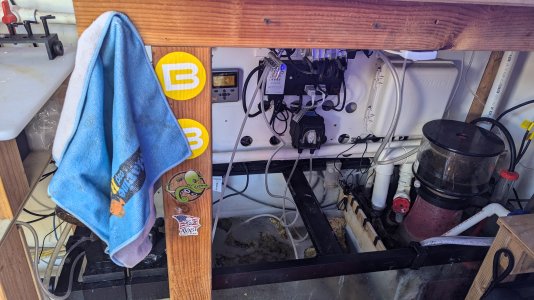cilyjr
Active member
First, I thought I had lost this account but thanks to the mods I was able to get back in!
In 2018. I packed up and moved from Rhode Island to the Central Coast of California.
I'm all settled in now with a new home and have been up and running with a 320 gallon display. All of my equipment is in a shed connected to the house because it is a very mild climate here. This system has been running since March of 2023. So as of today it is about a year and 4 months old.

Tank
The tank is just shy of 320 gallons 67x36x30.
It is plumbed through the back wall into a 4x8 lean-to style shed that houses all the equipment and connected frag tank. The sump is a standard 75 gallon AGA aquarium that I put baffles into.
Lighting
Display is lit with 6 Reefi uno 2.1 and four 54 watt t5 lamps.
Frag is lit with AI 3 hydra 32 hd.
Flow
Four ecotech mp40qd are all on the back wall and 2 jebao scp-150 on the sides. Jebao dc8000 return.
Control
I had been pretty heavily invested into Neptune systems since the aqua controller 3, as a result, I Am familiar with their environment. I stuck with them. I kept a lot of the pieces as I moved across the country and have kind of frankensteined it together.
Apex pro brain
2x eb8
Mxm
Pm1
Trident
2x dos pumps
Filtration
The skimmer is a bubble magus curve 9 elite.
Aqua UV 57 watt
Poly fil jammed between the baffles
And all the rock.
Additive
Avast Marine K2 kalkwasser stirrer
ESV B-ionic 2 part
Both controlled by the apex trident
I had previously used a calcium reactor when I initially set up but have decided the pH benefit from removing it has been positive. When I first set up I was using the kalkwasser reactor and the calcium reactor in tandem. When I remove the calcium reactor I switched to adding two part. I went with the b-ionic over diy as it states it has many other trace elements.
In 2018. I packed up and moved from Rhode Island to the Central Coast of California.
I'm all settled in now with a new home and have been up and running with a 320 gallon display. All of my equipment is in a shed connected to the house because it is a very mild climate here. This system has been running since March of 2023. So as of today it is about a year and 4 months old.
Tank
The tank is just shy of 320 gallons 67x36x30.
It is plumbed through the back wall into a 4x8 lean-to style shed that houses all the equipment and connected frag tank. The sump is a standard 75 gallon AGA aquarium that I put baffles into.
Lighting
Display is lit with 6 Reefi uno 2.1 and four 54 watt t5 lamps.
Frag is lit with AI 3 hydra 32 hd.
Flow
Four ecotech mp40qd are all on the back wall and 2 jebao scp-150 on the sides. Jebao dc8000 return.
Control
I had been pretty heavily invested into Neptune systems since the aqua controller 3, as a result, I Am familiar with their environment. I stuck with them. I kept a lot of the pieces as I moved across the country and have kind of frankensteined it together.
Apex pro brain
2x eb8
Mxm
Pm1
Trident
2x dos pumps
Filtration
The skimmer is a bubble magus curve 9 elite.
Aqua UV 57 watt
Poly fil jammed between the baffles
And all the rock.
Additive
Avast Marine K2 kalkwasser stirrer
ESV B-ionic 2 part
Both controlled by the apex trident
I had previously used a calcium reactor when I initially set up but have decided the pH benefit from removing it has been positive. When I first set up I was using the kalkwasser reactor and the calcium reactor in tandem. When I remove the calcium reactor I switched to adding two part. I went with the b-ionic over diy as it states it has many other trace elements.

